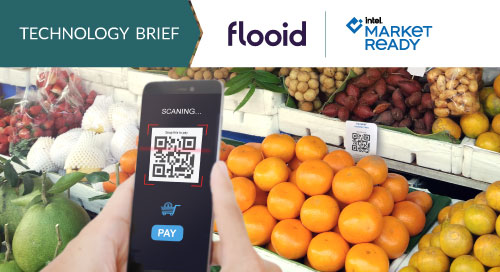Omnichannel Retail: Put Your Commerce Tech in One Basket

The global pandemic has caused retailers to come face to face with their customers’ adoption of hybrid digital and in-store shopping. Business survival has forced them to follow a customer’s journey across multiple verticals, channels, and devices. In today’s environment, merchants need to deliver a consistent and data-driven customer experience across every touchpoint.
The convergence of the physical and the digital is redefining retail. The beauty and strength of the physical storefront is being combined with the efficiency and intelligence of digital technologies.
One example is the rising trend for consumers to have retailer apps on their phones. And retailers are equipping store personnel with mobile devices to improve productivity, customer service, merchandising, and sales.
Edge Computing Powers Retail Agility
The dramatic swing of consumer shopping preferences, such as purchasing online and picking up in-store, has led to demand for consistent experiences regardless of interface, location, or device. To meet these multiple new operational challenges, retailers need:
- Data integration that enables omnichannel marketing potential, including information on all customer interactions during the different stages of their journey.
- Compelling marketing attribution to know the impact of various touchpoints on shopping behavior and measure the ROI of its marketing spend.
- A corporate focus on consumer privacy protection that meets legal requirements of national laws and social expectations of all customers.
All this demands a sophisticated edge computing strategy from point of sale to the usually benign “back-of-house” operations.
The beauty and strength of the physical #storefront is being combined with the efficiency and intelligence of #digital #technologies. @MakeItFlooid via @insightdottech
Flooid, a global provider of enterprise scale solutions for retailers, helps address these rapidly changing dynamics. Its Flooid Unified Commerce solution is a platform for delivering retail innovation (Video 1).
“The platform at its heart is a commerce engine that does all the fundamentals of the selling system, product price, promotion, basket, calculation, and payment,” says Martyn Osborne, Flooid’s CEO, EMEA and Group Chief Product Officer. “For example, it gives retailers options like consumer mobile, where the customers go into the store, scan products with their camera, using their fingerprint to pay, and then go.”
Microservice Infrastructure
By using open-source technology, the Flooid platform embraces a modern and flexible infrastructure. This design framework ensures scalable and robust operation that provides resilience from the in-store edge to the cloud.
It supports many different formats and touchpoints—grocery, general store, department store, fashion, pharmacy, food service, specialty, and more—through a single application architecture.
For example, Marks & Spencer, a large department store and grocery retailer in the U.K., wanted to build a consumer-based mobile app called “Scan Pay & Go”. Its in-house digital team developed the application. But the engine they use is the same that does all the pricing behind all of the endpoint applications that run in the store.
“They don’t have to come back to us every time they want to change that mobile app,” says Osborne. But what they are getting behind the scenes is all the heavy lifting such as pricing and promotions, payments, taxes, and more, which is complicated.
By using on-demand services for its core functionality, Flooid ensures that the customer can easily re-engage through other devices or channels no matter where a feature is first accessed. Its modern architecture extensively uses microservices to deliver operational speed and resilience through small-footprint edge POS devices, manager and associate tablets, and consumer personal devices.
This consistent and integrated approach to the customer experience embraces an omnichannel strategy while simultaneously respecting consumers’ privacy.
Scan, Bag, and Go
A fast-growing sign of how technology is redefining shopping is the broadening use of scan-bag-and-go technology. The first British chain to adopt this customer-facing technology was Flooid customer Waitrose, a high-end grocer. The key to its investment in payment technology was ensuring that it met customers’ needs.
The system developed through Flooid allows people entering a store to pick up a handset or download an app and use their mobile phones to scan products as they shop. This approach greatly improves the checkout experience and now represents about 40% of all in-store transactions.
As part of the company’s broader commerce strategy, the Flooid architecture includes a basket pricing system that services the self-scan solution to look up prices and customers on its commerce platform.
“They took our APIs and built their own front-end application on our engine. Other than our initial training, the Waitrose team developed the solution on their own,” says Osborne.
Staff Mobility Enriches Experiences
Still another innovative example is the recent deployment by a global grocery chain. With stores in Canada and the U.K., the organization was stuck using traditional in-store grocery processes. Margin pressures and competitive challenges motivated the retailer to adopt mobile 10-inch tablets to enhance customer interaction.
“We’ve done quite a lot with mobile technology,” Osborne says. “We’ve got a big acceleration now around many of our customers wanting to push mobile POS and other devices in their stores.”
This adoption also required the data access, durability, storage volume, and data transport bandwidth of a global cloud infrastructure. Flooid Unified Commerce, deployed on Google Cloud Platform, met this challenge through its ability to leverage its robust microservices architecture to deliver speed and resilience to in-store edge devices.
Intel® technology is an integral part of Flooid solution deployments. The company’s technology leadership shows its presence from back-end cloud servers to handheld edge devices. Mobile technology accelerates both POS and mobile device performance. And network edge operations feature small-footprint devices that can consume and process large amounts of data at the edge.
Along with its innovative technology, the effectiveness of the Flooid solution comes down to the company’s operation mindset. “We have a full 365-degree kind of visibility of the whole life cycle from inception, development, production, operations, and support,” says Osborne. “We deliver the full-stack service.”